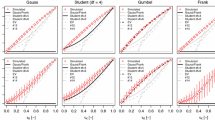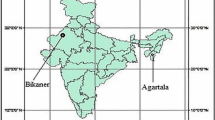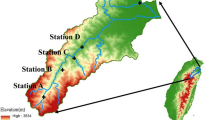Abstract
The spatial dependence of rainfall is usually studied considering pairs of rain gauges and analysing the behaviour of Pearson’s correlation coefficient with respect to the distance between the two devices. However, this measure of linear dependence involves the underlying hypothesis that the data follow a bivariate normal distribution. When the data are skewed, as in the case of rainfall, a preliminary transformation is often performed in an attempt to obtain the required bivariate normality. This approach does not always guarantee satisfactory results, resulting in correlation estimator that exhibits bias and high variance. In this work, the inter-gauge dependence is studied by applying the alternative non-parametric Kendall’s rank correlation coefficient and the upper tail dependence coefficient. Exploiting the link between these two indices with copulas allows building an exploratory graphical method useful to drive the definition of a regional 2-copula suitable for the description of the data. Then, this copula is used to generalize the Shimizu’s bivariate mixed model, providing some freedom in the choice of the dependence structure and marginals. The analysis is performed on seven years of rainfall observations with 30-min time resolution collected by 35 gauges located in Central Italy. The effect of zero-measurements and several aggregation time scales are considered as well. Results of this study support some conclusions previously appeared in literature; mainly that only positive contemporaneous pairs of rainfall observations correctly describe the inter-site dependence.
















Similar content being viewed by others
References
Bárdossy A (2006) Copula-based geostatistical models for groundwater quality parameters. Water Resour Res 42 W11416. doi: 10.1029/2005WR004754
Burlando P, Rosso R (1996) Scaling and multiscaling models of depth-duration-frequency curves for storm precipitation. J Hydrol 187(1–2):45–64
Capéraà P, Fougères A-L, Genest C (1997) A nonparametric estimation procedure for bivariate extreme value copulas. Biometrika 84(3): 567–577
Chen X, Fan Y, Patton A (2004) Simple tests for models of dependence between multiple financial time series, with applications to U.S. equity returns and exchange rates. Financial Markets Group, London School of Economics, Discussion Paper 483, 2004; Available from: http://fmg.lse.ac.uk/∼patton/parametriclatest.pdf
Cherubini U, Luciano E, Vecchiato W (2004) Copula methods in finance. Wiley, Chichester
Ciach GJ, Krajewski WF (2006) Analysis and modeling of spatial correlation structure in small-scale rainfall in Central Oklahoma. Adv Water Resour 29:1450–1463
De Michele C, Salvadori G, Canossi M, Petaccia A, Rosso R (2005) Bivariate statistical approach to check adequacy of dam spillway. J Hydrol Eng 10(1):50–57
Embrechts P, McNeil AJ, Straumann D (2002) Correlation and dependence in risk management: properties and pitfalls. In: Dempster MAH (eds) Risk management: value at risk and beyond. Cambridge University Press, Cambridge, UK, pp 176–223
Embrechts P, Lindskog F, McNeil AJ (2003) Modelling dependence with copulas and applications to risk management. In: Rachev ST (ed) Handbook of heavy tailed distributions in finance. Elsevier/North-Holland, Amsterdam, the Netherlands, pp 329–384
Favre A-C, El Adlouni S, Perreault L, Thiémonge N, Bobée B (2004) Multivariate hydrological frequency analysis using copulas. Water Resour Res 40:W01101. doi: 10.1029/2003WR002456
Fermanian J-D (2005) Goodness-of-fit tests for copulas. J Multivar Anal 95(1):119–152
Frahm G, Junker M, Schmidt R (2005) Estimating the tail dependence coefficient. Insurance: Math Econ 37:80–100
Frosini P (1977) Il Tevere: le inondazioni di Roma e I provvedimenti presi dal governo italiano per evitarle. Accademia nazionale dei Lincei, Roma (in Italian)
Genest C, Favre A-C (2007) Everything you always wanted to know about copula modeling but were afraid to ask. J Hydrol Eng 12(4):347–368
Genest C, Quessy J-F, Rémillard B (2006) Goodness-of-fit procedures for copula models based on the probability integral transformation. Scand J Stat 33:337–366
Grimaldi S, Serinaldi F (2006a) Design hyetographs analysis with 3-copula function. Hydrol Sci J 51(2):223–238
Grimaldi S, Serinaldi F (2006b) Asymmetric copula in multivariate flood frequency analysis. Adv Water Resour 29(8):1115–1167
Ha E, Yoo C (2007) Use of mixed bivariate distributions for deriving inter-station correlation coefficients of rainfall. Hydrol Process. doi:10.1002/hyp.6526
Habib E, Krajewski WF, Ciach GJ (2001) Estimation of rainfall interstation correlation. J Hydrometeorol 2:621–629
Herr HD, Krzysztofowicz R (2005) Generic probability distribution of rainfall in space: the bivariate model. J Hydrol 306:234–263
Hosking JRM, Wallis JR (1997) Regional frequency analysis: an approach based on L-moments. Cambridge University Press, Cambridge
Joe H (1997) Multivariate models and dependence concept. Chapman & Hall, New York
Nelsen RB (1999) An introduction to copulas. Lecture Notes in Statistics 139. Springer, New York
Panchenko V (2005) Goodness-of-fit test for copulas. Physica A 355:176–182
Press WH, Flannery BP, Teukolsky SA, Vetterling WT (1992) Numerical recipes in FORTRAN: the art of scientific computing. 2 edn. Cambridge University Press, Cambridge
Renard B, Lang M (2007) Use of a Gaussian copula for multivariate extreme value analysis. Adv Water Resour 30:897–912
Salciarini D, Godt JW, Savage WZ, Conversini P, Baum RL, Michael JA (2006) Modeling regional initiation of rainfall-induced shallow landslides in the eastern Umbria Region of central Italy. Landslides 3: 181–194
Salvadori G, De Michele C (2004) Frequency analysis via copulas: theoretical aspects and applications to hydrological events. Water Resour Res 40:W12511. doi: 10.1029/2004wr003133
Salvadori G, De Michele C (2006) Statistical characterization of temporal structure of storms. Adv Water Resour 29:827–842
Schmidt R (2003) Dependencies of extreme events in finance—Modelling, statistics, and data analysis. Dissertation University of Ulm
Schmidt R (2005) Tail dependence. In: Cizek P, Härdle W, Weron R(eds) Statistical tools in finance and insurance. Springer, New York
Schmidt R, Stadtmüller U (2006) Non-parametric estimation of tail dependence. Scand J Stat 33:307–335
Shimizu K (1993) A bivariate mixed lognormal distribution with an analysis of rainfall data. J Appl Meteorol 32:161–171
Sklar A (1959) Fonction de répartition à n dimensions et leurs marges. Publications de Institut de Statistique Université de Paris 8: 229–231
Yoo C, Ha E (2007) Effect of zero measurements on the spatial correlation structure of rainfall. Stoch Environ Res Risk Assess 21:287–297
Aknowledgments
The author whishes to thank S. Grimaldi. The reviewers and G. Villarini are acknowledged for their revisions, which greatly helped in improving the manuscript. Finally, the CNR-IRPI and the Umbria Regional Hydrometeorological Service are aknowledged for kindly providing the data.
Author information
Authors and Affiliations
Corresponding author
Rights and permissions
About this article
Cite this article
Serinaldi, F. Analysis of inter-gauge dependence by Kendall’s τK, upper tail dependence coefficient, and 2-copulas with application to rainfall fields. Stoch Environ Res Risk Assess 22, 671–688 (2008). https://doi.org/10.1007/s00477-007-0176-4
Published:
Issue Date:
DOI: https://doi.org/10.1007/s00477-007-0176-4




